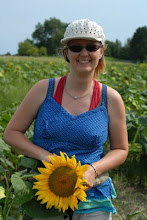I did learn a couple things or two along the way: a major one being if the fat burns it smells and if you makes soap from smelly lard it will still smell burnt as a bar of soap as well... so, don't use burnt lard, use that to make birdseed cookies with instead... they don't seem to mind.
Needed to make lard:
- a turkey fryer with propane tank and large pot.
- a clean bucket with metal sieve to drain cracklings
- a metal pot with mesh sieve and cheese cloth to filter rendered lard
- a clean bucket with lid to store rendered lard
- a bucket or large box with bag for drained cracklings
- a cutting board and sharp knife to cut fat down
- large plastic gloves to protect hands and arms from fat splatter
- a large flat spoon to agitate rendering fat
- a spoon to scoop rendered lard from cooking pot
- a mesh spatula to remove cracklings from lard
A box of fat strips. I cut the fat up in two inch strips, size does not matter too much as long as they are mostly the same so the smaller fat pieces or cracklings don't start to burn before the larger fat pieces are done.
The main thing to keep in mind is that to cook fat down to lard without burning the fat pieces you need a starting amount of lard. You might want to cook down some fat indoors on the stove (easier to control heat, smaller pot) and use that as starter lard in the turkey fryer. I would have about half a pot of lard and add about the same amount of fat (no higher than the ring indentation of the pot which is the maximum oil level) for a full load. I would be able to do about three full loads in about five hours.
Another thing is to keep an eye on the temp of the lard, to not let it get too hot. When the lard starts to smoke you're burning it! It's a fine balance between turning up the propane when adding cold fat and turning down the heat when the fat is hot and starts to melt / render to keep it simmering until it's all rendered.
I used a double layer of cheese cloth to sieve the lard I would scoop from the top of the turkey fryer. Do NOT pour hot lard into a plastic bucket, it will melt the bottom!
The sieved lard would go into a food grade plastic bucket. By this time the lard is cooled off enough it does not melt the plastic. When the bucket is full close with well fitting lid and store somewhere cool, like on a concrete floor in the basement (or in the freezer).
Collect all the cracklings in something. These make good winter bird food as well as winter chicken feed. I set the box in the chicken run and the dozen girls took about a month to eat the whole thing, and it never got moldy or buggy. Not all that healthy as chickens that are too fat don't lay well, but it did not seem to matter - this time :) If possible, bag it up in smaller portions and freeze to feed later when it's really freezing.













No comments:
Post a Comment